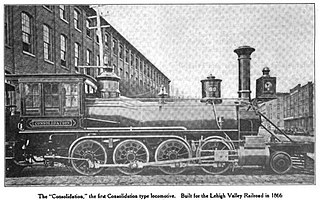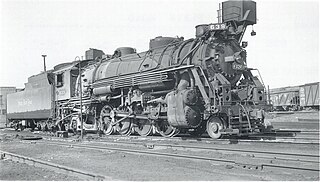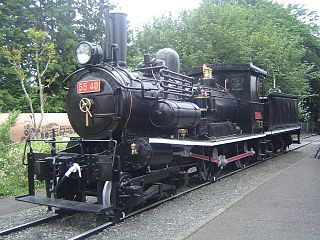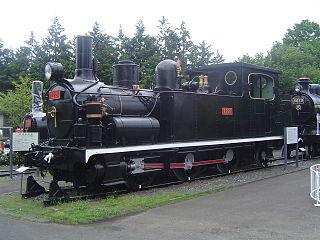
A locomotive is a rail transport vehicle that provides the motive power for a train. If a locomotive is capable of carrying a payload, it is usually rather referred to as a multiple unit, motor coach, railcar or power car; the use of these self-propelled vehicles is increasingly common for passenger trains, but rare for freight trains.

A steam locomotive is a locomotive that provides the force to move itself and other vehicles by means of the expansion of steam. It is fuelled by burning combustible material to heat water in the locomotive's boiler to the point where it becomes gaseous and its volume increases 1,700 times. Functionally, it is a steam engine on wheels.

0-6-0 is the Whyte notation designation for steam locomotives with a wheel arrangement of no leading wheels, six powered and coupled driving wheels on three axles, and no trailing wheels. Historically, this was the most common wheel arrangement used on both tender and tank locomotives in versions with both inside and outside cylinders.
The UIC classification of locomotive axle arrangements, sometimes known as the German classification or German system, describes the wheel arrangement of locomotives, multiple units and trams. It is used in much of the world, notable exceptions being the United Kingdom and North America.

Under the Whyte notation for the classification of steam locomotives, 2-8-0 represents the wheel arrangement of two leading wheels on one axle, usually in a leading truck, eight powered and coupled driving wheels on four axles, and no trailing wheels. In the United States and elsewhere, this wheel arrangement is commonly known as a Consolidation, after the Lehigh and Mahanoy Railroad’s Consolidation, the name of the first 2-8-0.

Under the Whyte notation for the classification of steam locomotives, 2-8-2 represents the wheel arrangement of two leading wheels on one axle, usually in a leading truck, eight powered and coupled driving wheels on four axles and two trailing wheels on one axle, usually in a trailing truck. This configuration of steam locomotive is most often referred to as a Mikado, frequently shortened to Mike.

Under the Whyte notation for the classification of steam locomotives, 0-10-0 represents the wheel arrangement of no leading wheels, ten powered and coupled driving wheels on five axles and no trailing wheels. In the United Kingdom, this type is known as a Decapod, a name which is applied to 2-10-0 types in the United States. In the United States, the type is known as ten-coupled.

The Railway Museum is a railway museum in Saitama, Saitama, Japan, which opened on 14 October 2007. It was built and is operated by the East Japan Railway Culture Foundation, a non-profit subsidiary of the East Japan Railway Company. It consists of a 19,800 m² building on a site covering 42,500 m², with a display area 9,500 m² in size.

The NZR BC class comprised a single steam locomotive that operated on New Zealand's national rail network. Built for the Wellington and Manawatu Railway (WMR) and classified as No. 17, it passed into the ownership of the New Zealand Railways Department (NZR) when the government purchased the WMR in December 1908, and it was then that it acquired the BC classification as BC 463.

The Mooka Line is a Japanese railway line connecting Shimodate Station, in Chikusei, Ibaraki and Motegi Station in Motegi, Tochigi. It is the only railway line operated by the Mooka Railway. The third sector company took over the former JR East line in 1988. In addition to regular diesel local trains, the line also operates the SL Mooka steam service for tourists using a C12 class steam locomotive.

The Kamaishi Line is a 90.2 km (56.0 mi) rural railway line in Iwate Prefecture, Japan, operated by the East Japan Railway Company. It connects Hanamaki Station in the city of Hanamaki with Kamaishi Station in the city of Kamaishi.

The Class E10 (E10形) is a type of 2-10-4T steam locomotive built by the Japanese Government Railways (JGR). They were numbered E10 1-E10 5. They were built in 1948 and designed by Hideo Shima.

The Class C51 (C51形) is a type of 4-6-2 steam locomotive built by Kisha Seizo Mitsubishi and Japanese National Railways (JNR) Hamamatsu Works. The C classification indicates three sets of driving wheels. The C51 introduced 1.75 m diameter driving wheels to Japan. C51s raised the average speed on the Tōkaidō Main Line from 47.3 km/h (29.4 mph) to 55.3 km/h (34.4 mph). In 1930, a C51 hauled the first Tsubame (swallow) express, reducing travel time between Tokyo and Kōbe to 9 hours.

The Class 9600 (9600形) is a type of 2-8-0 steam locomotive built by Japanese Government Railways from 1913. The Class 9600 was the first type of locomotive to be mass-produced by Japanese manufacturers. The Class 9600 were popularly known as Kyuroku (nine-six), and were extensively used for freight service throughout Japan.
They were numbered 9600-9699, 19600-19699, 29600-29699, 39600-39699, 49600-49699, 59600-59699, 69600-69699 and 79600-79669. All 770 remained in service until the 2nd of March 1976, when all steam-hauled service on JNR's network has been phased out.

The JGR Class 5500 was a type of 4-4-0 steam locomotive used for 60 years on Japanese Government Railways. The locomotives were built by Beyer, Peacock & Company in England. Sulfur was added to the forged steel used for the cylinders. The cylinders were set in a slightly canted position and were used without replacement for the entire life of the locomotive. Japan was unable to produce cylinders of comparable durability. In 1929, ten were converted to tank locomotives and reclassified as Class B10.

The JGR Class 2120 was a B6 type 0-6-2 steam tank locomotive used on Japanese Government Railways for shunting and pulling freight cars. The earliest locomotives of this type were imported from Great Britain. One is preserved at the Ome Railway Park in Ome, Tokyo.

The JGR Class 5100 (5100形) was a type of 4-4-0 steam locomotive used on Japanese Government Railways. The two locomotives, numbered 18 and 20, were built by Kitson and Company in the United Kingdom in 1874 as 0-6-0 locomotives of the later JGR Class 7010. They were rebuilt into 4-4-0 wheel arrangement passenger locomotives at Kobe in 1876. In 1909, the two locomotives were classified Class 5100, becoming numbers 5100 and 5101.

The Cape Government Railways 4th Class 4-4-2 of 1897 was a South African steam locomotive from the pre-Union era in the Cape of Good Hope.

The Class 8620 (8620形) is a type of 2-6-0 steam locomotive built in Japan from 1914 to 1929. It was Japan's first mass-produced passenger locomotive. A total of 672 Class 8620 locomotives were built. Originally they had a symmetry of line with shapely cast iron chimneys which gave way to plainer chimneys and smoke deflectors were added in later years.

The Class 4110 (4110形) is a class of 0-10-0 steam locomotives built by the Japanese Government Railways (JGR) and designed by Hideo Shima. A total of 39 locomotives were built by Kawasaki Shipyard.



















